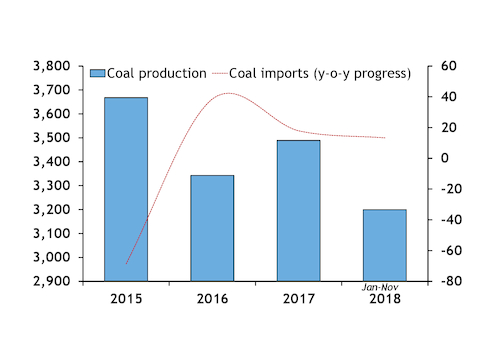China Coal Supply May Increase in 2019

January 3, 2019 - China's domestic coal supplies are likely to increase this year, as the country brings more efficient, advanced coal capacity on line, while pressure to cut capacity at older mines tapers off.
Capacity increases at modern, efficient mines have been relatively modest over the past three years, but these expansions are likely to accelerate in 2019, with the government's new strategy envisaging the development of larger mines to replace those that have closed. At the same time China will slow its intense pace of cutting excess capacity to a more modest rate this year, as the country is set to achieve its 13th five-year target for capacity reductions ahead of schedule.
China may exceed its 2018 target for a 150mn t/yr reduction in coal capacity because a number of provinces and regions have over-delivered on targeted closures of outdated coal mines. Its second-biggest coal-producing province, Shanxi, reduced capacity by 23.3mn t/yr in 2018, the Shanxi government said in mid-December. This was 900,000 t/yr more than its capacity-reduction target set early last year. And eastern China's Shandong province had eliminated 4.85mn t/yr of capacity by the end of November, more than the targeted reduction of 4.65mn t/yr for 2018.
China reduced its coal production capacity by at least 690mn t/yr in 2016-18, with 250mn t/yr removed in 2017 and 290mn t/yr in 2016. This means that mine closures should now slow, because no more than 110mn t/yr needs to be cut in 2019 to reach the 800mn t/yr reduction target set for the 13th five-year period of 2016-20.
A slower pace of closures means more emphasis is likely to be placed on building bigger mines than those being retired. Since February 2018, China's top economic planning agency, the NDRC, has allowed some new mines to have 300pc more capacity than the outdated mines they are replacing, in cases where power generators have more than a 50pc share in mining firms, or vice versa.
The government initially limited the capacity of new mines to that of those they replaced, mainly because this was part of China's coal capacity elimination strategy announced in 2016 to address overcapacity. But the government loosened this restriction in 2017 to allow capacity replacement across provinces at 130pc of closed capacity.
China had approved 800mn t/yr of new capacity by the end of August 2018, exceeding the amount of outdated capacity that has been closed since 2016 and equaling the 13th five-year capacity reduction target.
Rail system planner and operator China Railway has laid out a plan to increase rail capacity for transporting coal, focusing on lines that serve the key coal-producing regions of Inner Mongolia and Xinjiang, Shanxi and Shaanxi provinces, major coal-handling coastal ports and Yangtze river ports. This could help improve domestic supply by removing bottlenecks caused by limited rail capacity in peak coal demand periods.
China Railway plans to upgrade the Tanghu, Wari and Menghua lines — which connect Shanxi and Inner Mongolia to ports in northern China — to heavy-haul railways that can ship more than 10,000t on each train by 2020. And it will raise the capacity of the Ningxia and Houyue lines — which connect Shaanxi to eastern China's Jiangsu province and Shanxi to central China's Henan province, respectively — by 12mn t/yr.
China Railway has not given a timetable for the capacity rises, but analysts expect the capacity to ship coal out of Inner Mongolia to increase next year.
China's coal production increased on the year in most months in 2018, except for a fall of 2pc in July. Output reached 3.21bn t in January-November, up by 5.4pc from the same period a year earlier (see chart).
Stronger Chinese output poses downside risks to demand in the global seaborne coal market, as it would subdue the country's demand for imports. The biggest year-on-year increase in the country's coal imports in 2014–18 came in 2016, when it rose by 38.5mn t to 170mn t, as domestic production fell by 325mn t to 3.3bn t.

China coal production vs growth in imports mn t

